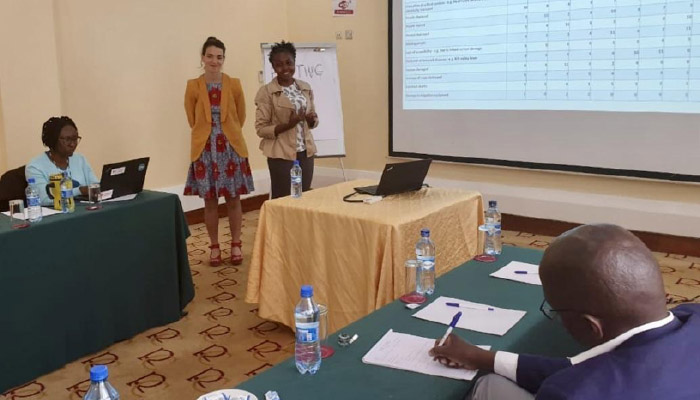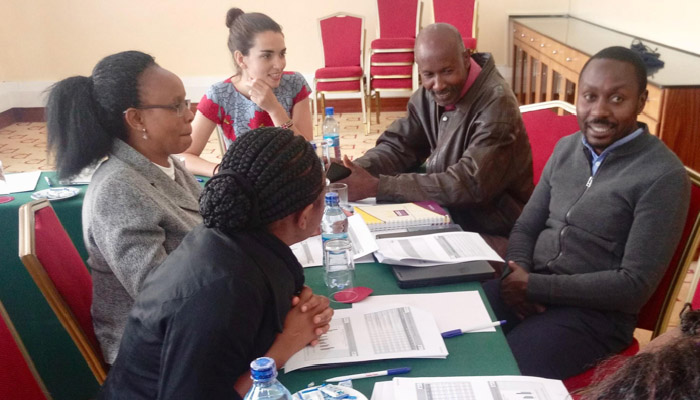 |
 |
 |
 |
notes from the field
This is a personal blog and does not reflect the views of the Red Cross Red Crescent Climate Centre
Sarah Posner
Kenya
June - September, 2019
Prioritizing Drought Impacts: Where, When, and for Whom? Insights from the Technical Working Group
August 19, 2019
View photo gallery for more photos in the field by Sarah Posner
The time is flying by and I can’t believe I am already halfway through my placement at the Kenya Red Cross headquarters in Nairobi. Over the past two weeks, the office has been relatively quiet as most officers and interns were attending various workshops and meetings elsewhere in the country. While the solitude was a nice change of pace for the time being, I am happy that most of the office has returned this week. I missed sipping my morning chai in the company of my desk mates and spending lunch breaks sharing laughs over full plates of pilau at nearby tented restaurants. These small moments shared with my colleagues are the memories I will cherish most from my time working here at the Kenya Red Cross Society.

Over the past several weeks, I have worked closely with the data preparedness team on Forecast Based Financing (FbF), compiling various data sources of various drought impacts. We also conducted some preliminary analysis of the historical trends over time, with the aim of better informing an objective prioritization of which impacts are most significant, based upon data availability while addressing its limitations. Today marked a turning point in the project, as today I presented the findings of this research conducted thus far, along with my colleague Naomi, at the Technical Working Group (TWG) meeting. The TWG meets monthly and is comprised of technical experts who represent different disaster intervention institutions who are key stakeholders in the decision-making process. Some of the representatives in the room today included: the Kenya Meteorological Department (KMD), the National Disaster Management Unit (NDMU), and National Disaster Operations Center (NDOC), to name a few.
Prior to the meeting, each stakeholder ranked thirteen drought impacts in order of what they considered to be of most significance. The scores were averaged and ranked by the data team and presented at the TWG which were discussed further in small group discussions. The top five for drought in descending order of significance were: 1) food insecurity, 2) outbreak of water and vector-borne disease, 3) water scarcity, 4) malnutrition, and 5) resource-based conflict. Many of the stakeholders were surprised by this ranking, with many individuals expecting to see such impacts as livestock death or reduced crop yield, which relate to rural livelihoods, ranked higher on the list. This led to a reflective discussion about the prioritization process, which was based upon the knowledge base and personal experiences of participants mostly from urban areas. Hence, it would be of interest to repeat the exercise to include other participants dependent on rural livelihoods to see how the rankings would change.

Reaching a consensus as to which impacts are most significant poses challenges due to the complex nature of drought, which operates across multiple scales with a wide variety of impacts depending on their magnitude (Kossida et al., 2012). Additionally, quantifying these factors is still challenging due to data limitations. The only thing everyone in the meeting could agree upon is that droughts have different impacts on different people who live in different places. For instance, a crop farmer in the Central Province of Kenya may suffer from crop failure or low yields due to water scarcity, while a pastoralist in the Northern Arid and Semi-Arid Lands may experience livestock migration or even death due to lack of pasture. The underlying and recurrent issue down to scale is a fundamental problem that, in the discipline of human geography, I find myself always thinking about. A geographic perspective can offer insights by integrating the particularities of place, to prioritize relevant impacts that are context-specific due to the multiplier effect of droughts which tend to exacerbate local issues of a vulnerable society. Thus, we have decided to take a livelihoods-based approach to prioritize separate impacts based upon whether they will affect agriculture, pastoral, or agro-pastoral which will inform early action that is site-specific and relevant for different people in different places.
Kossida M, Kakava A, Tekidou A, Iglesias A, Mimikou M, 2012. Vulnerability to Water Scarcity and Drought in Europe. Thematic assessment for EEA Water 2012 Report. ETC/ICM Technical Report 3/2012, European Topic Centre on Inland, Coastal and Marine Waters, Prague.

